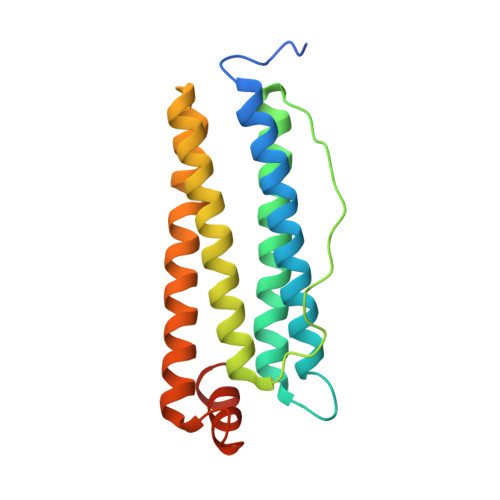Re-designing ferritin nanocages for mercuric ion detection.
Wang, Y., Chen, H., Zang, J., Zhang, X., Zhao, G.(2019) Analyst 144: 5890-5897
- PubMed: 31497803
- DOI: https://doi.org/10.1039/c9an01110b
- Primary Citation of Related Structures:
6JPS - PubMed Abstract:
Protein nanocages have recently received considerable attention in the fields of nanoscience and nanomedicine and have been used as either biotemplates for the preparation of a variety of nanomaterials or vehicles for drugs or imaging agents. However, their utilization for detection of heavy metal ions has yet to be explored. In this study, by grafting a mercury binding peptide (MBP) on the exterior surface of a recombinant human H-chain ferritin (rHuHF) nanocage, we successfully prepared a new protein nanocage (HuHF-MBP) which exhibits high binding capacity and affinity for Hg2+. The fluorescence of HuHF-MBP labeled with a green fluorescent dye fluorescein isothiocyanate (FITC) can be quenched by graphene oxide (GO), while addition of Hg2+ to the above solution recovered the quenched fluorescence in a dose-dependent manner. Thus, this system consisting of FITC-labeled HuHF-MBP and GO, where FITC and graphene oxide were used as fluorescent reporter probes, has great potential to be explored as a sensor for Hg2+ detection. Indeed, this newly constructed protein sensor exhibited high sensitivity and selectivity for Hg2+, and the limit of detection was 1.0 nM. The construction of this system provides an alternative strategy for the preparation of heavy metal ion sensors by using protein nanocages as biotemplates.
Organizational Affiliation:
Beijing Advanced Innovation Center for Food Nutrition and Human Health, College of Food Science and Nutritional Engineering, China Agricultural University, Beijing Key Laboratory of Functional Food from Plant Resources, Beijing, 100083, China. xiuqingzhang@cau.edu.cn gzhao@cau.edu.cn.














